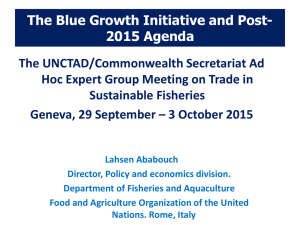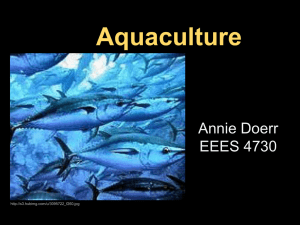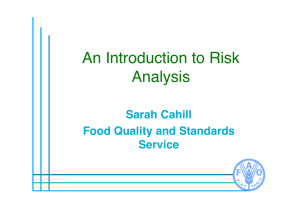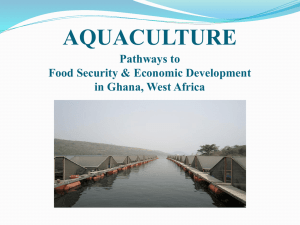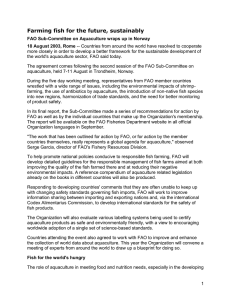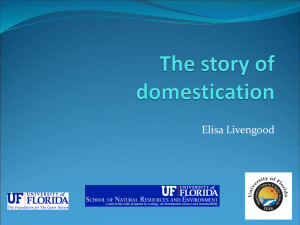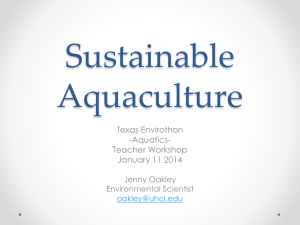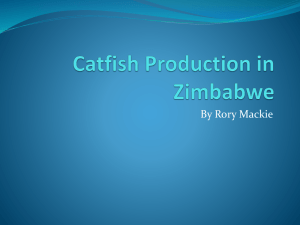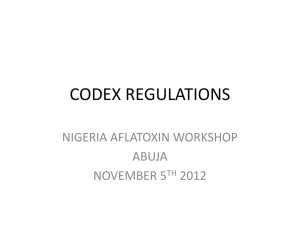International Guidelines to ensure quality and safety of farmed fish
advertisement
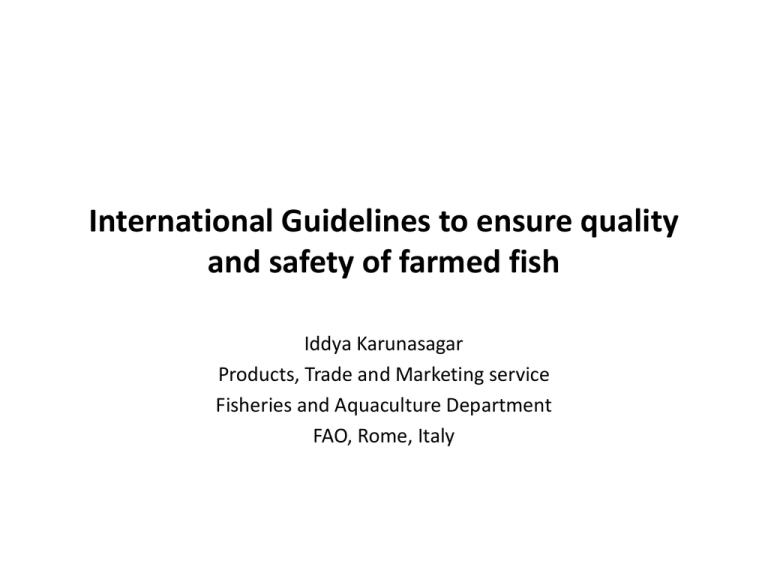
International Guidelines to ensure quality and safety of farmed fish Iddya Karunasagar Products, Trade and Marketing service Fisheries and Aquaculture Department FAO, Rome, Italy Supply/demand of fish Trends in fish supplies Fish supply-demand gaps S-D gap (mt) Africa Supply 2030 Demand 2030 S-D gap 2030 11.7 18.7 -7.0 156.5 186.3 -29.8 Europe 18.6 23.4 -4.8 L.A. & C. 16.2 18.3 -2.1 Northern A. 6.2 12.9 -6.6 Oceania 1.5 1.8 -0.3 210.7 261.2 -50.6 Asia World Source: Estimation of FI Department Per capita fish demand in 2020 estimated based on assumptions: –GDP per capita projection by IMF –Prices unchanged –Preference unchanged Total fish demand in 2030 estimated based on: –Estimated per capita demand in 2020. –UN population projection in 2030. –Non-food fish demand unchanged Results: –Supply < Demand •51 mt shortage –S-D gaps decline in all regions •Largest insufficiency in Asia Consumer concerns • • • • • Food safety Sustainability of supplies Environmental impact of the system Animal welfare Socioeconomic issues Source: Outbreak Alert Report, CSPI, USA. Source: Outbreak Alert Report, CSPI, USA Source: EFSA report Source: EFSA Report Source: EFSA Report MARKET ACCESS REQUIREMENTS • International agreements: World Trade Organisation- Sanitary and Phytosanitary (SPS) Agreement; Techinical Barriers to Trade (TBT) • National and regional regulatory requirements: eg EU Regulations, US FDA requirements • Requirements of large retailer chains: eg various certifications CODEX ALIMENTARIUS COMMISSION The Joint FAO/WHO Food Standards Programme Since 1962 INTERNATIONAL PUBLIC STANDARDS • • • • • Standard setting (Codex Alimentarius Commission) Adoption (National Governments) Implementation (Government agencies) Conformity assessments (public/private agencies) Enforcement (Government agencies) CODEX ALIMENTARIUS COMMISSION Risk assessment questions FAO/WHO Microbiological issues JEMRA Chemicals, Residues of Vet drugs JECFA Pesticides JMPR Reports of risk assessments, JECFA, JMPR evaluations Procedure followed for development of FAO Technical Guidelines Expert consultations Technical consultation with Member Governments Approval by the Sub-Committee on Fish Trade/Aquaculture Approval by the FAO Committee on Fisheries FAO Technical Guidelines for Aquaculture Certification • Minimum substantive criteria – Animal Health and Welfare (reference to OIE Guidelines for animal health) – Food Safety – Environmental integrity – Socioeconomic aspects • Institutional and procedural requirements – – – – Governance Standard setting Accreditation Certification Summary and conclusions • Aquaculture is essential to meet the food requirements of the world population • International guidelines exist to ensure that aquaculture operations are performed to ensure food safety, sustainability, minimisation of environmental impact, animal health and welfare, and address socioeconomic concerns THANK YOU
